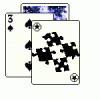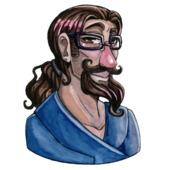This is just a kernel of an idea at the moment. My question is simply: Does this Sound fun? Yes/no? Why/why not?
Overview
The idea is based around the idea of your weapons being other characters, companions on your journey. The overall art style would be stylized in a way reminiscent of a Legend of Zelda or an Okami. Generally the game will progress through puzzles and combat situations and combinations thereof in very similar ways as the character travels though an overworld and enters themed dungeons that progress the story.
The major difference is that the main character, let's call her 'Diamond' will not have any significant combat abilities, they'll simply be the Chosen One, or a great tactician/strategist, or some combination thereof. Early in the game, after being introduced to the world, Diamond befriends Ruby, a tempestuous girl with fire powers. Together they begin their journey and Ruby, is able to light up dark places, cut through wooden obstacles, burn dangerous plants and of course spit that hot fire that makes enemies cower and die. She of course, has personality for days to balance your generaly silent protagonist, and when you lock onto something you can ask her to interact with it, attack it, defend it or defend you (with the face buttons), and she'll respond. You quickly discover that she has a weakness, that she will act in rage if you are hurt at all, giving a kind of swing to combat scenarios. Soon you discover that by completing optional or additional objectives you can find trinkets, epiphanies and weapons that will help Ruby boost her range or be able to cut through denser materials, and even learn to keep her cool.
Multiple Companion Control
And then you meet O.J. who is dressed in orange, to complement Ruby's red and your white. O.J. is that big dumb strong gentle giant type and he has the ability to move large objects, hold things open and when he can get close to an enemy, he can hold them or pack a mean punch, as well as is a pro at guarding you against projectiles and throwing you across chasms too big to leap across. This allows you to explore even more new areas and complete a second more challenging dungeon. Perhaps you rescue O.J. from that dungeon, and he has his own storyline where he is an outcast amongst his people for a crime he didn't commit, and in dealing with him you learn of his hesitancy to act because of this experience, so he can be really slow to 'activate' at times. In this process, you learn to switch "weapons" (using the shoulder buttons) and can either be commanding Ruby, O.J. or both together. In this sense, you are using these two characters, who each have their own personas, as your 'weapons' which you fire or command as needed. You upgrade these weapon-people as you find new things in your adventures to help you overcome new challenges in platforming and combat.
Over the course of your adventures you meet four additional characters, each with different platform/puzzling abilities, attacks, defensive capabilities, weaknesses and varied default activities when you're not controlling them depending on what's going on around them, and of course, varied dialogue bits with you and with each other. As your party grows, they all travel with you visibly through the world, following along and poking at things randomly as AI characters in an RPG generally do. You also may be able to 'train' them to have specific priorities in combat. Depending on how deep the system should be developed to keep the free adventure feel of the game, perhaps you can configure different sub-groups for commands, as well as different 'do this when this happens.' All of these training options would be unlocked or collected through the course of adventuring with these people. Alternately these switches could be triggered in a more invisible way, such as spending time with Ruby and her family makes her more likely to defend you from closer attackers than be aggressive and take out ranged targets. At various points you leave certain party members behind for either platforming or story reasons and are forced to concentrate on combinations of just a few of them, to ensure you get to spend a bit of time to fall in love with each weapon.
Other party members may include 'Amber' a shy catgirl who can find/sense invisible enemies and transforms into a huge tiger-thing your whole party can ride on to traverse the overworld; 'Jaden,' a know it all Link-wannabe who does a heap of the expositional narration usually reserved for companions like Navi and Otacon, 'Azure III,' a shapeshifting water creature who can turn into a variety of handy forms as you teach him to, and 'Amethyst,' a psionic entity who can possess other creatures to recruit them temporarily to your cause. Each comes with their own persona, available commands, attacks, defenses, weaknesses and utilities. The overall effect once you defeat Amethyst and she joins you is very similar to what you feel when you have everything full as Okami or Link except that means having six characters who, ideally, are now engaging to you in their own special ways, so you also have that feeling of a full party in an RPG compounded together. The idea is that seeing your six new friends, each of which you've fought together, bled together, seen them at their weakest moments and they've spent the whole time protecting you and allowing you to do incredible things, seeing them together in battle should be a thing of beauty, especially as you unlock 'teamwork combinations' that allow them to play off of each other, and you point them in the right direction at the right moment in the right sequences to defeat a difficult boss or room of baddies.
Setting Fluff and Obstacles
Speaking of, the game itself would take place in a mystical kingdom against an appropriately themed enemy such as "Onyx" and his army "The Quartz" or some such. They want to turn everyone into statues so that they can live in a perfect world without sin or something. Lots of monsters with crags growing out of their skin, lots of little villages to explore while your party also explores showing their independence when you are relatively safe. Perhaps draw from African folklore of some sort, or take inspiration from something even less likely to fuel a fantasy setting, like the American South or something. The climax would likely involve you losing your friends one after another as they are captured or turned into statues and you face Onyx alone with nothing but your knowledge and tactics gained from throughout the game in order to outmaneuver and out last him and eventually claim the throne and now have command over a whole kingdom, with the help of your friends that have proven their ability to lead in varied areas. Or maybe you absorb your friends magics instead for a final battle as a super character who can switch powersets on a whim. Maybe a combination of both could be fun, actually.
Conclusion
Designing it is supposed to be fundamentally similar to designing any other puzzle/platformer action/adventure game. Rooms you can't access, ledges you can't get to, chasms you can't cross, triggers you don't know how to trigger, baddies who aren't affected by your current attacks, collectibles you can't find, liquid levels that need to rise or fall, doors that need to open, visibility that needs to be gained, geometry that needs to be moved, baddies to survive or avoid and of course, bosses to kill. There are new considerations, of course, in terms of the placement of these characters and their AI being such that they are both helpful, not hurtful and not conflicting or falling over each other. A stripped down more indie-friendly version would just have two weapons, such as Ruby and O.J. perhaps turn Amber from a mount into a narrator/clue giver for a third, and keep it to one really big dungeon though with three separate acts/sub-sections. A proof of concept might just have Diamond and Ruby trying to get out of a room and then having to fight a mini-boss.
I'm not sure what I'd call this game exactly. But my question is: does it sound like it could be fun? Or is the idea of not directly attacking an opponent in a combat situation seem un-fun? Any other comments or questions would be more than appreciated.









